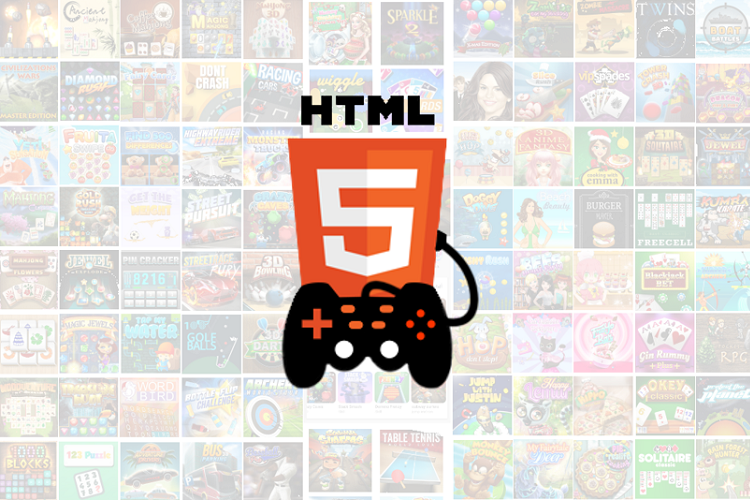Are you interested in game development?
Would you like to create cross-platform games that can be played on smartphones as well as on browsers?
If the answer to the above questions is yes, then HTML5 is for you.
You may already know that Apple doesn’t allow Flash to run on iOS devices and that Adobe no longer offers Flash for mobile. This leaves HTML5 as your only solution when developing cross-platform games.
What is an HTML5 Game?
The term “HTML5 games” is a bit of a misnomer. Despite the prevalence of this term, it’s mainly used as a catchy buzzword because it’s difficult to create a decent game using HTML5 in isolation.
You are probably already familiar with HTML (Hyper Text Markup Language); HTML5 is just the fifth version of this.
HTML is a markup language, which means that it is used to format and arrange the elements in a document. Markup languages are designed to present computer text in a way that is easily understandable for humans. Generally, HTML is supported by other technologies, such as CSS (Cascading Style Sheets) and JavaScript.
As HTML isn’t a true programming language, HTML5 isn’t well suited to write the complex logic that is needed to create a game. Generally, when people refer to “HTML 5 games,” they mean games that have been built using HTML5 in conjunction with JavaScript and CS
When developing HTML5 games, contrary to the name, your principal tool will be JavaScript. As JavaScript is a true programming language, it is capable of writing the kind of logic needed to create a computer game.
To use a simple analogy, HTML5 is used to create a drawing board, but JavaScript is used to actually sketch your game onto the drawing board.
Why Use HTML5?
When HTML5 was released way back in 2012, people thought it would render Flash completely useless and relegate it to a thing of the past. However, it took some time for teething problems to be ironed out and for things to be standardized across different browsers.
Moving to the present day, HTML5 is very easy to work with. It has excellent browser support and is complemented by a variety of tools that can be used when developing a game.
One of the best things about using HTML5 instead of Flash when developing a game is that it enables the content to run on mobile devices. Who doesn’t browse the internet on a mobile device nowadays? Ensuring your game can be played on a smart phone is key to increasing its reach, and you would be doing yourself and your game a huge disservice by not ensuring your game is playable on a mobile device.
Another benefit of using HTML5 to build your game is something that can’t be replicated by native mobile games. Instead of having to add your game to the marketplace in the hope that potential players might select it amongst the thousands of competing apps, with HTML5 you have the ability to distribute your game via a hyperlink. The power of this feature really shouldn’t be underestimated. It massively increases your options for marketing and distributing your game, and if you want to get really creative, you can even use a hyperlink to jump to a specific part of the game or share your progress with a friend.
Which Game Engine Should I Use?
A game engine is basically just a helping hand when it comes to developing a game – a tool that takes care of the less exciting aspects of developing a game and leaves you free to focus on the fun, creative parts. Commonly, game engines are used for asset loading, audio, sprite maps, physics and animations.
However, you don’t necessarily need a game engine, so before we get into the specifics of which game engine is best for you, ask yourself if you really need one. Ultimately, it’s your choice; using a game engine will speed up the process, but by building the game without the help of a game engine, you might find that you develop a better understanding of the intricacies of your game. As a rule of thumb, the simpler the game, the less you need the help of a game engine.
If you decide that you would like to try out a game engine, there is a plethora to pick from. It’s nice to have choice, but be aware that some of these might stop being updated, so make sure you pick a game engine that has a history of regular updates.
Html5gameengine is a fantastic resource when choosing a game engine. While it doesn’t have an exhaustive list of game engines, the engines it does list are well known and maintained.
If you would like to make things a lot easier, you can consider using a game maker such as Construct. By using a game maker, you bypass any of the actual JavaScript programming and instead use the game maker’s editor. If you enjoy the logic of programming and are interested in the coding side of game development, a game maker is probably not for you. However, if you are willing to relinquish some control over the end result and are content with fewer options to customizing your HTML5 games, a game maker may be a good option. In return, you will benefit from user-friendliness and potentially significant time savings.
Getting Started with HTML5
There is a whole host of material available online to help you get started in your HTML5 journey and see you on your way to creating your first HTML5 game.
If you’ve chosen a game engine, their website could be a great place to start as they’re usually very generous with tutorials and other useful information.
For technical help, there’s a lot to be found here and here.
If it’s the mechanics of games you’re more interested in, try here and here.
Making Your HTML5 Game A Success
So you’ve developed your HTML5 game – now what?
It’s not enough to have a functional game. You want players to like the game, return time after time, and hopefully even purchase something, if that’s a feature your game supports.
Features like customizable user accounts, high scores and achievements to unlock will get the dopamine flowing and encourage your players to come back. Integration with social media channels and the option for in-game purchases can also be successful in increasing player satisfaction and getting people hooked on your creation.
For help and motivation from fellow game designers, why not reach out to the community and post on some forums? Don’t be intimidated or afraid to ask for help – at some point, everyone was a beginner, and most people are friendly and willing to offer helpful advice. If you don’t ask, you won’t learn.
Making Money
Monetizing games can be very lucrative for the developer – think of all the in-game payments available in most mobile games.
A leader in this area is King.com, creator of all the most popular games in the “match-three” style, including the infamous Candy Crush Saga. Take inspiration from some of their most successful games.
Advertising is another common way of making your game work for you. It’s fairly straightforward: select an ad network and incorporate ads into your game.
Distributing Your Game
After all your hard work, you want people to play, and hopefully enjoy, your game.
One of the best features of HTML5 is the variety of options you have for distributing your creation.
Many marketplaces accept HTML5 games as they are, though each has slightly different requirements. However, certain marketplaces mandate that you have a native wrapper for your game, though there are some tools online available to help with this.
Final Thoughts
That was a quick, whistle-stop tour of HTML5 and how and why you should use it to develop your next computer game.
If you’re new to game development or HTML5 be sure to use the resources mentioned in this article and those available further afield on the internet. Whatever problem you might run into while developing HTML5 games, I can almost guarantee there’s an article about it somewhere – and if not, there are plenty of game developer communities available who would be happy to help you.
So, what are you waiting for? Have fun, get learning, and see what you can create.












+ There are no comments
Add yours